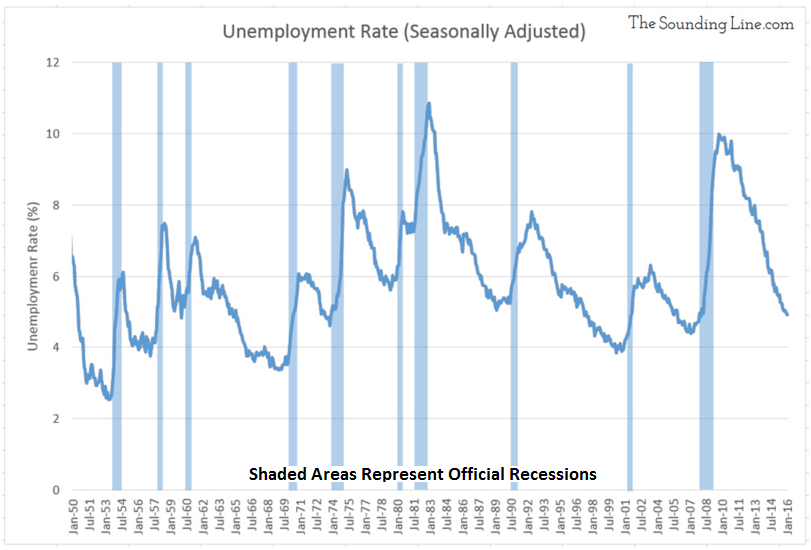Submitted by Taps Coogan on the 8th of March 2016 to The Sounding Line.
Enjoy The Sounding Line? Click here to subscribe for free.
Enjoy The Sounding Line? Click here to subscribe.
Recently, even the most staid of “economists” are now referencing unemployment statistics as the means to support the notion of an improving U.S. economy. While matched in more than equal part by serious skepticism (read here), a much more fundamental question needs to be addressed when using the unemployment rate to forecast the economy.
How did the unemployment rate, historically acknowledged as a lagging indicator, become the leading indicator of choice to forecast the health of the U.S. economy?
The chart below shows the U.S. unemployment rate since 1950 with periods of official recession shaded. After an inspection of the graph two things become clear:
- Since 1950, without exception, any significant worsening of unemployment (increase in unemployment rate) has happened after a recession has been declared, never before. This is why the “unemployment rate” has historically been considered a lagging indicator. The lag between labor markets reacting clearly to economic changes and the tallying of the labor statistics is so great that the U.S. is often already in a recession by the time the unemployment rate finishes improving.
- As stated, recessions have quickly followed every single major low in unemployment since 1950. In fact, the average time between the maximum low in unemployment and the next declaration of recession is 3.8 months, the maximum is 10 months, less than year. Three times since 1950 (’57, ’73, ’90) a low in unemployment has been followed by recession and an explosion in unemployment in less than one month. Another way to state this is: “The best harbinger of a coming recession is when the BLS starts publishing numbers that suggest that the nation is approaching full employment (low unemployment).”

Keeping in mind that the formal declaration of a recession trails the true start of a recession, the answer to our question is exceedingly clear.
Unemployment is not a leading indicator of the economy and is not predicative, even in the near future. The unemployment rate has always been highly dynamic; it doesn’t stay at the lows or the highs for long.
Today’s odd obsession with the unemployment rate certainly doesn’t have its roots in economic fundamentals, or in the teaching of the craft. Like so many things these days, it instead stems from a misunderstanding of the importance of the indicator and its chronological place in the art and science of forecasting. The unemployment rate is not a highway sign declaring in bold letters what the traveler is most certainly going to find up the road. Rather, it is a sobering reminder to the informed traveler that the best is likely to be seen in their rear view mirror.
So what explains the recent focus on unemployment? The Fed has taken upon themselves the mandate to maintain full employment and so, regardless of the true utility and timeliness of the statistic, unemployment factors strongly into Fed policy. In a world were the most important dynamic in the economy, the cost of risk via interest rates, is set by Fed dictate, it is no surprise that the misconceptions of a few within the Fed can so easily become the misconceptions of many. In the end, the endless analysis focused on the unemployment rate as a “real time” indicator is at best an attempt to forecast the whims of the Fed, not the economy.
Would you like to be notified when we publish a new article on The Sounding Line? Click here to subscribe for free.


Brilliant mate! We have been asking ourselves that very question since the end of term #1.
Recession by October 2016+- triggered by a June tightening by the FED.Mark
But the real unemployment rate today in America is about 23 (twenty three) percent!!
… [Trackback]
[…] Read More Infos here: thesoundingline.com/unemployment-how-does-a-lagging-indicator-become-a-leading-indicator/ […]
… [Trackback]
[…] Read More here|Read More|Find More Informations here|There you can find 194 additional Informations|Infos to that Topic: thesoundingline.com/unemployment-how-does-a-lagging-indicator-become-a-leading-indicator/ […]